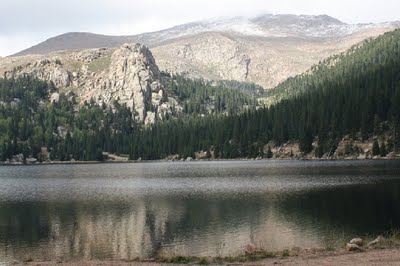Update: At the meeting the end of April, they presented a mostly final Pikes Peak South Slope plan that included several things that were brought up in this meeting.
The Pikes Peak South Slope recreation meeting on Tuesday was very well attended. I counted somewhere close to 130 people.
There weren’t any major surprises from what I wrote before the meeting based on what I had heard. After writing that I also obtained a copy of the concept plan.
The written plan doesn’t have any information in it about who’s going to pay to build the trails and parking lots or how it’s going to be maintained. It turns out that’s because they really don’t have a plan. It did seem pretty clear that it’ll include user fees and could include a private company managing it.
Tom, the presenter, said they want to phase in access and trails because they don’t want to rush and damage a sensitive area. Barry from the Gazette said that we’re already 11 years into the process and he didn’t feel there was any danger of rushing into it. He also brought up that the Denver Water Board also manages recreational access to similar areas.
The reason given for not having a plan that would include a section of the Ring the Peaks Trail was that the Forest Service doesn’t want a new trail. CSU doesn’t want to build a trail that would deadend at the Forest Service boundary. Although I think the Forest Service is reluctant to build the trail, it seems they’re both pointed at the other and using it as an excuse rather than working together.
Their main reason for restricting mountain bikers is the bighorn sheep. There’s believe to about 200 sheep in the area. Utilities was told by a biologist that the speed of bikes scares the sheep. They didn’t know if there were studies showing that. Jim from Medicine Wheel pointed out a study in Canyonlands referenced on the IMBA site that showed that hikers caused significantly more severe responses from desert bighorn sheep than mountain bikers.
I don’t know how the response is similar between desert sheep and our high country bighorn sheep. Still it seems that they are using the sheep as a way to keep mountain bikes out and possibly don’t have sufficient scientific data to back it up. Maybe the area should just be closed to all users during the lambing season.
The main recreation groups of hikers, mountain bikers, equestrians and fishers were well represented. There were also a few rock climbers, hunters. When they asked for who was there for the various types of recreation, it looked like over half the room raised their hands for both mountain biking and hiking. That’s not surprising since there’s a lot of people that do both. Equestrians represented about 20% with a smaller number of fishermen.
Most of the equestrians were happy with the initial plan. I didn’t get a good feel for how hikers felt other than being disappointed about the Ring the Peaks Trail. Mountain bikers definitely weren’t happy about not getting access to the South Slope reservoir area.
If you didn’t make the meeting but want to make comments, fill out the comment form due by February 26th. There’s information on the Watershed Access Project page for emailing it to CSU. They plan to have another public meeting in April with plan refinements based on the feedback they receive. They plan to finish up the planning phase by June.
– UltraRob
|
|
|
Tags: Colorado Springs, hiking, mountain biking, Pikes Peak





 Blog RSS Feed
Blog RSS Feed Like on Facebook
Like on Facebook Follow on Twitter
Follow on Twitter Flickr
Flickr Contact
Contact

Great post Rob. You summed up the meeting pretty well and the issues that still remain.
I am hoping that many will take the chance to provide their input/feedback/suggestions via the online comment form on the CSU website. It's our chance to have our opinions noted as part of the process.
Cheers,
Allen
Unfortunately I could not attend the meeting. Private management? Like PP Highway, increasing fees with limited hours of operation! There is never a plan, this City is reactionary not visionary.
[…] there along with over 60 others. There were some positive changes based on the feedback given on draft Pikes Peak South Slope Plan presented in […]
[…] Pikes Peak South Slope Meeting January 2010 […]